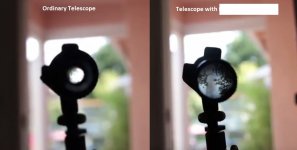Thanks for bringing this up, Lee.
I visited the Leica Microsystems website and read everything I could find on the subject of Leica's FusionOptics. As usual the marketing material doesn't really provide the reader with quite enough information to understand completely how the thing works, so this is my best guess. Perhaps someone from Leica will correct me if I'm wrong.
It appears that a full aperture/full resolution image is sent to one eye. The other eye gets an image from an aperture stopped down small enough to restrict the effective pupil size of that eye, thus increasing its DOF while sacrificing some resolution. The brain takes the "best" information from each eye and combines them into an image with both high resolution and wide DOF. You may notice that in this scheme one side will have to be brighter than the other, but there could be several ways to equalize the image brightness and make both sides acceptably bright in an instrument, like a microscope, with its own artificial light source.
I made a crude binocular example of this system, just to see if it works outside of microscopy, by stopping down one side of my 8x56 FL to 15mm. I set up targets in a fairly dark room, one at about 18' and the other just in front of it at about 16.5'. I focused on the more distant target with one eye open to about 3.75 mm. I could easily see that the closer target (when moved to the field center) was in better focus through the side stopped down to 15mm, indicating the expected wider DOF with my eye's pupil effectively restricted to 1.9mm. When I looked with both eyes I found that the wider DOF was more or less what I still "saw", even though only one eye actually saw it. Apparently my brain had chosen the "better" side to dominate the image. The thing I cooked up seems to offer pretty good evidence, at least to me, that the principle behind FusionOptics works (provided I understand it properly), but obviously a binocular with one normal exit pupil and one tiny exit pupil would not be very desirable.
Henry





